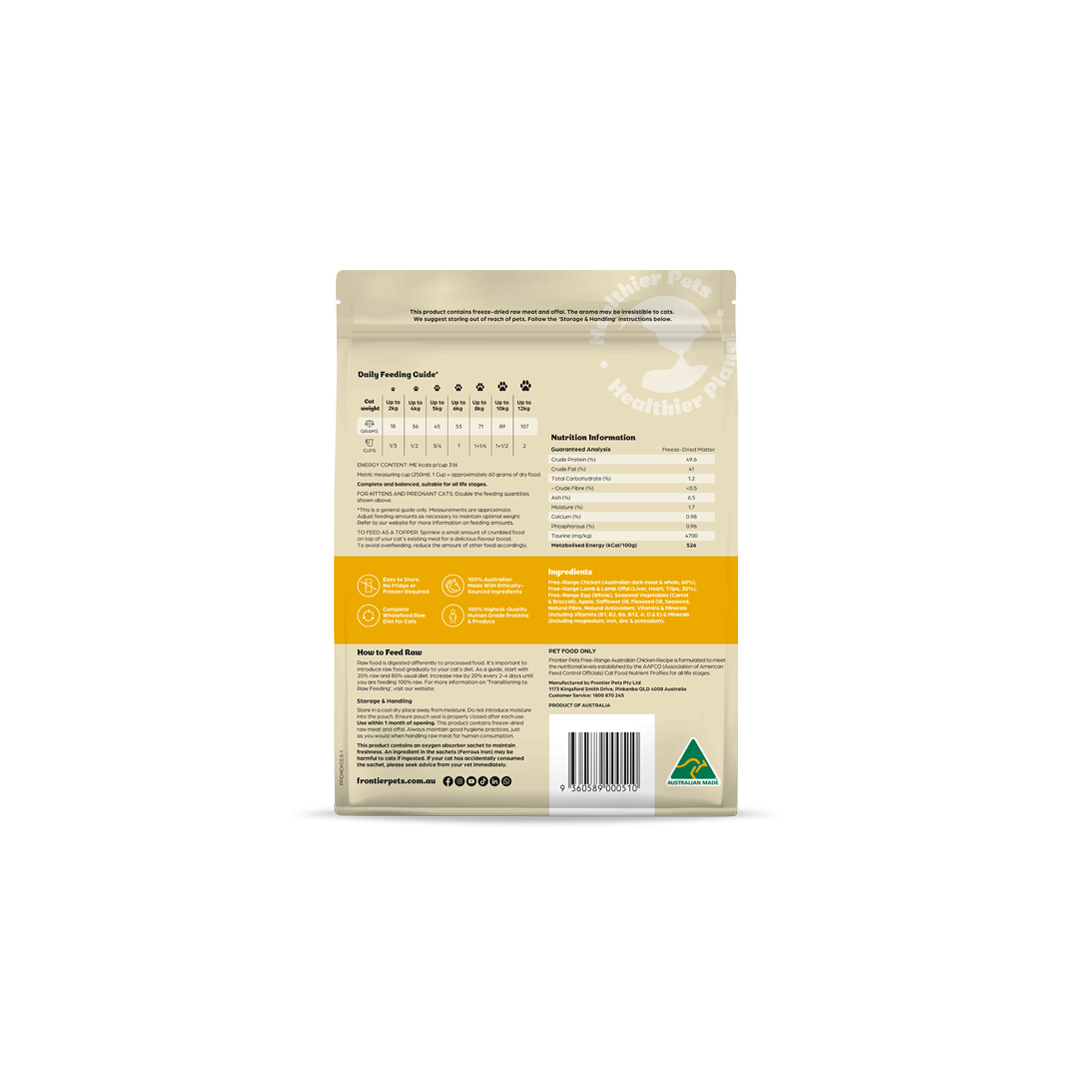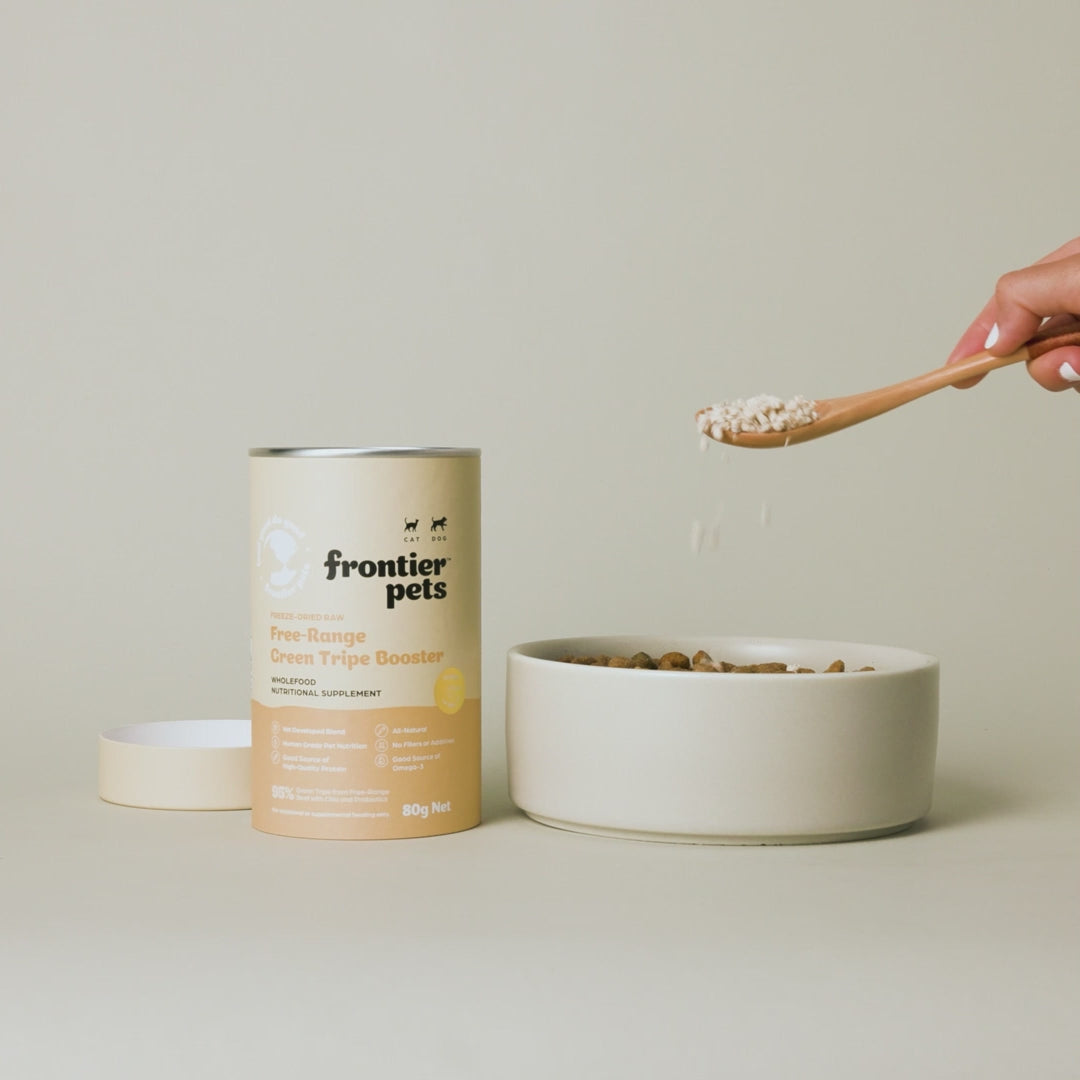Freeze-Dried Raw Cat Food
Filters




Cats are not small dogs—their nutritional needs are entirely different. As obligate carnivores, they thrive on animal-based diets with minimal carbohydrates. In the wild, a cat’s ideal meal is a whole prey animal, providing the perfect balance of meat, organs, bones, and fat—exactly what their bodies are designed to digest. At Frontier Pets, we believe in feeding cats the way nature intended—high in real, raw meat, with the essential nutrients they need to thrive
Need help?
Frequently Asked Questions
Write a clear and concise answer to guide your customers.Our cat food stands out from other brands because it combines the benefits of raw nutrition with the convenience of freeze-dried preparation. Unlike conventional cat food found in the pet food aisle, our recipes use free-range and organic ingredients to create a complete and balanced diet for your cat. Frontier Pets cat food caters to natural carnivores, providing high-quality, human-grade ingredients that are ideal for fussy eaters, cats with sensitive stomachs, or those needing long-term health support. With a focus on grain-free food and no low-grade ingredients, we offer nutritious cat food that promotes healthier lives and peak health for your feline.
The best food for cats is one that aligns with their natural diet as obligate carnivores—high in animal protein, healthy fats, and essential nutrients, with minimal carbohydrates.
Key features of a high-quality cat diet:
✔ Raw or minimally processed for maximum nutrient retention
✔ High in real meat, bones, and organs to mimic a natural prey diet
✔ Low in carbohydrates—cats don’t need grains or fillers
✔ Rich in Omega-3s & healthy fats for skin, coat, and brain health
Frontier Pets Freeze-Dried Raw Cat Food is designed to provide complete and balanced nutrition that’s as close to nature as possible, without the hassle of raw food prep.
Each type of cat food has its pros and cons, but the best choice depends on your cat’s health, lifestyle, and nutritional needs.
- Wet food – Hydrating and palatable.
- Dry food (Kibble/Raw Freeze-Dried) – Convenient but may need additional moisture.
- Raw food – Closest to a cat’s natural diet, rich in protein and nutrients, but can be time-consuming to prepare.
Best option? Frontier Pets Freeze-Dried Raw Food combines the benefits of raw feeding with the convenience of dry food—simply add warm water, and it’s ready to serve!
When choosing the best food for your cat, focus on nutrient-dense, species-appropriate ingredients such as:
✔ High-quality animal protein (e.g., free-range chicken, beef, fish, lamb)
✔ Organ meats (liver, heart, kidney) for essential vitamins and minerals
✔ Healthy fats (Omega-3s from fish and flaxseed) for skin, coat, and brain health
✔ Bone or calcium sources for strong bones and teeth
✔ Minimal carbohydrates (avoid grains, fillers, and artificial additives)
Cats can be picky eaters, so transitioning to a new diet should be done gradually to avoid digestive upset. Follow this simple step-by-step transition guide:
1️⃣ Start small – Mix 10-20% of the new food with their current food.
2️⃣ Increase gradually – Over 7-14 days, slowly increase raw food while decreasing old food.
3️⃣ Serve at room temperature – Cats prefer food that mimics the warmth of fresh prey.
4️⃣ Monitor digestion & appetite – Look for signs of good digestion (firm stools, healthy coat, energy levels).
5️⃣ Be patient! – Some cats take longer to adjust—keep offering the new food without forcing.
Free-range and organic ingredients ensure your cat receives food that is free from harmful additives and preservatives, supporting better overall health and digestion. Just like humans thrive on non-processed, whole foods, our pets benefit from natural, nutrient-rich diets too. These premium ingredients mimic the natural diet of cats, providing optimal protein sources for strong stomach acid and active lives. By choosing free-range and organic options, such as our freeze-dried meals, you’re giving your cat a diet that promotes sensitive skin health, supports a perfect weight, and enhances long-term health, all while being kind to the environment and animal welfare.
Our cat food is crafted with ethically sourced, free-range meats as the primary ingredient, ensuring your cat receives the high-quality protein they need as natural carnivores. We also include organic seasonal fruits and vegetables, essential vitamins, minerals, and a selection of supplements to provide a complete and balanced diet. Unlike low-grade, mainstream meat-based cat foods, our recipes are free from unnecessary fillers and carbohydrates, making them perfect for pets with food sensitivities or health concerns like flaky skin or sensitive stomachs. Every ingredient is carefully selected to ensure your cat enjoys a healthy body weight and peak health.
Human-grade ingredients ensure the safety of food production and provide higher nutritional value compared to low-grade pet food ingredients. By choosing human-grade, you’re giving your cat high-quality ingredients free from contaminants and harmful additives often found in conventional cat food. Our Frontier Pets freeze-dried raw food offers the finest cat food with human-grade ingredients, supporting a healthy diet for cats at any life stage, from kitten to adult.
Cats, as natural carnivores, have no biological requirement for carbohydrates in their diet. High-carb content in conventional cat food can lead to weight gain and digestive issues, particularly in cats with sensitive stomachs. Our freeze-dried raw cat food is grain-free and low in carbohydrates, focusing on high-protein, meat-based nutrition that supports strong stomach acid and optimal health. By limiting carbs, we ensure your cat maintains a perfect weight and lives a healthier life.
Blog posts

Best Low Maintenance Dog Breeds in Australia
Choosing your new fluffy companion is never easy. There is a wide range of considerations that go into finding the perfect pup for you! From your lifestyle to your living arrangements, it’s importa...
Read more
Steps With Pets Charity Challenge, August-September 2025
Steps with Pets – Tottenham Hotspur’s global charity dog-walking challenge, supported by Frontier Pets Calling all dog-loving Spurs fans around the world! This is your chance to combine your pass...
Read more
Tottenham Hotspur partners with Frontier Pets - for Healthier Pets and a Healthier Planet
Exciting news for Frontier Pets soccer (ahem, football) fans! We've teamed up with Tottenham Hotspur FC to support their groundbreaking Supporter's Club for dog-owners,Tottenham Hostpaw. Read the...
Read more


















